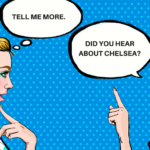Ah, the terror of the blank page.
That blank screen – that blinking cursor – that unstarted fundraising appeal – staring back at you from the void.
Waiting for you to let it soar with a clear, powerful, captivating lead… or send it crashing to the ground with a bland, rambling lead.
Because you already know: if you can’t anchor your donor’s interest early, you’ve got trouble.
And even when you’ve followed all the foundation steps the experts recommend… even when you know… who you’re writing to… why you’re writing… what you want your donor to do, and when… and you have all your background and even a creative brief or outline…
You can STILL struggle for a way to start and frame your lead and kickstart the story in your fundraising appeal. Panicked your beautiful story will stay locked forever in the Land of Bad Leads – and all the good your appeal could do will be lost.
Fear not, my fellow fundraiser.
The following frames for fundraising leads have helped me kickstart my way out of a bad lead more than once, and I promise they can help you too.
You’re not swiping the copy word for word, obviously – your story is unique. But every single lead frame you’ll see has been field-tested: they work.
#1: Start with a surprising detail
When you have an appeal story that’s got a unique, shocking, heartrending, or surprising detail, it can make sense to capture your reader’s attention early by sharing that detail. (You can also build to a later reveal of the detail.)
Here’s how I started the true story of a boy called Anthony — and it MUST be truth. Making stuff up or exaggerating for drama is dead wrong and unethical.
It was Christmas morning at the shelter.
“Go ahead,” I said. “Bring me another one. I’ll help you put it together.”
But the other toys just peered out at me from under Anthony’s bed. Tightly, as if it might
disappear, the wide-eyed boy clutched the single toy I’d assembled for him.
Then he asked me gently, “Is it okay if we just play with this one?”
Dear Donor Name,
Until he was eight years old, no one ever bothered to give Anthony a gift.
So on this Christmas morning, he was happy. But Anthony was also worried. He wanted to save the other gifts, just in case they were the last he would ever receive.
The letter then goes on to talk about the gifts a donor can give to children like Anthony that Christmas, in donating. The gifts of family and healing. Safety and comfort. And so on.
But you can see how, if you or I had jumped right to that offer, all the emotional power of Anthony’s story would have been forever lost to page 2 or 3 or 4.
# 2: Frame it with a possibility question
If you’ve never framed the lead of a fundraising appeal with a possibility question, get ready for an a-ha moment. They can work for any organization, and can be especially effective for hospital foundations and medical research charities that are famous for worrying they don’t have any good stories to write about. But the work they’re doing brims with lifesaving possibility, with the vision of a whole different tomorrow.
That’s where you can frame your fundraising appeal with a possibility question. Like this:
Dear Donor Name,
What if a single $50 dose of medicine meant you’d survive the deadliest form of stroke?
What if an x-ray could determine the exact right cancer treatment for you?
And what if a hospital would join a new clinical study, just to get you that treatment?
For the record, this copy wasn’t mine. And it was written many years ago. But the instant a client sent it to me, I knew it had wings to fly – and What If leads still fly today because they paint the picture of a better tomorrow that your supporter can help bring about, in giving.
You can also use Wouldn’t it be great if… or What if there was a way to… or even turn it around to add drama to a situation like a rescue, which I’ve done for animal welfare, with a simple: What if no one had been there to rescue Bluebelle that day?
And in a single sentence, your story is off and running.
One last note: even if you don’t end up using what you write, the Possibility Lead Frame can serve as an amazing writing prompt to get you moving.
# 3: Get granular
This lead frame came about in the hottest days of summer for a client who helped people who found themselves homeless and were often struggling with addiction. In our kickoff call, we realized there was an untold story: the weather was lovely, and most people didn’t have a clue that living on the streets in summer could be especially brutal. All we had were story snippets – glimpses of people who passed through their centre to get some relief. So we went granular, and framed the lead (again, a true story) by focusing on one beneficiary’s shoes.
You can do the same with almost any distinct or unusual micro-detail that speaks volumes about why help is needed, with just a few sentences. Like this:
Dear Donor Name,
As he passed in MQI’s doorway, I almost forgot to speak.
All I could think about were his shoes.
There were holes in the toes, and his feet poked out through threadbare socks.
The letter goes on to put the reader directly into that man’s shoes for almost the entire first page before asking for a donation. It outperformed everything like it for many summers running, and some version of it may still be doing good things today.
If your story lends itself to the Get Granular Frame, you could also try focusing on a baby’s hands, a scar on a homeless dog or cat’s body, a charm or faded photo someone carries in their pocket, the sky’s the limit.
The point is to bring that micro-detail front and center, and use it to frame your story.
# 4: Harness the power of imagination
For this lead, you need to know just two words, Imagine and Picture. The neuroscience behind both is powerful: by asking your reader to imagine – even when it’s negative – you’ve given their brains a space in which to fully and safely experience your story.
Here’s a look at the Imagination Lead Frame in action:
Imagine your lungs burn like fire from the moment you wake.
You are only a child.
But today you will suffer skin made raw by toxic water, and a ragged cough from logging companies that pollute the air and lay waste to the forests and rivers of your village for easy profits.
Here’s another. You can also use Implied Imagine or Picture, and drop the reader right into the deep end with “You.” Like this:
Dear Donor Name,
You will wake in that hazy half-light before dawn.
There isn’t enough food. So on this day you save the small pot of porridge for your sleeping family. Today you will walk with an empty belly.
See? No Imagination or Picture needed. Start with You, and the reader is instantly there.
# 5: Use the situation as the story
Everyone wants that big, epic lead. But let’s face it. When we as fundraising copywriters are saying the bravest, truest thing we can, sometimes the big epic lead IS the situation. Especially when it’s dominating our global or local landscape.
And the best example I can give of the Situation Lead Frame, is COVID, where we emblazoned the situation even before the letter began, above the salutation:
===== URGENT CRISIS APPEAL ======
PLEASE HELP OUR SISTERS AND BROTHERS AROUND THE WORLD WHO ARE IN DIRE NEED DURING THE COVID-19 PANDEMIC.
Your emergency donation now will help Trócaire put lifesaving resources where they’re needed most during this unprecedented humanitarian crisis.
===============================
It doesn’t focus on the story of one – and of course, everything can’t be a crisis. But when the situation needs to be front and center, put it there.
#6: Start with “I’m writing to you…”
While the “I’m writing to you” Lead Frame is tried and true, and can serve as another great writing prompt to get you started when no other path will take you out of the Land of Bad Leads, you don’t want all of your letters to start that way.
But sometimes, “I’m writing to you” can work wonders. As it did here:
Dear Donor Name,
I’m writing to you today because I urgently need your help to stop people from dying of hunger in East Africa.
And here:
I’m writing to you about a terrible situation unfolding for Cuba’s street dogs.
Like I said, you don’t want to use “I’m writing to you” every time. But from time to time – and anytime as a prompt to help you get to the heart of what you want to say – it’s hugely effective and has stood the test of time.
Next time you’re lost in the Land of Bad Leads, I hope these faithful lead frames light your path out and guide you to fundraising appeal success.
This world needs you, fundraisingologist. Go forth and do great good!
Award-winning fundraising copywriter Lisa Sargent is on a mission to transform the way nonprofits tell their fundraising stories. Founder of SOFII’s free Donation Thank-You Letter Clinics and a contributing author to Change For Better, Sargent has helped top nonprofits from Trócaire to Best Friends Animal Society to get far better results, inspire and keep more donors, and build a better world.
Writing for fundraising is a challenge. Would you like some one-on-one coaching on your writing and strategy? Schedule a free 25-minute call with one of our Fundraisingologists. They will give you great free advice, and help you identify which Coaching+ program might be right for you. Click here to book your call.
Related Blog Posts:










